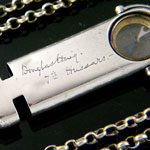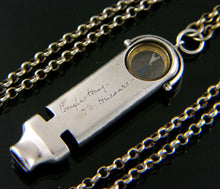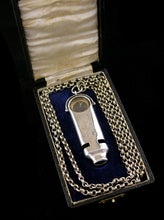Captain (later Field Marshal 1st Earl) Haig’s Silver Combination Whistle and Compass
Adding product to your cart
Measurements: Length: 8cm (3.25in)
Provenance: Gift of Sir Douglas Haig during the Great War
The silver body fitted with swivel mounted attachment loop, working compass, and engraved with the autograph ‘Douglas Haig / 7th Hussars’. Made by William Hornby. Retailed by Vickery of Regent Street, London. Complete with chain and fitted case. Hallmarked London 1893
Read more
1893 was the year in which thirty-two year old Douglas Haig returned to India to rejoin his regiment, 7th Hussars, having unsuccessfully competed for a place at the Staff College, Camberley. En route to India he wrote a forty-page report on the French cavalry manoeuvres in Touraine, before rejoining the regiment into which he had been commissioned in 1885. His stay in India was short lived for he soon returned to the United Kingdom as A.D.C. to the Inspector General of Cavalry. Haig was finally nominated to enter the Staff College in late 1894, a common practice in the day for promising candidates. While waiting to take up his place, he travelled to Germany to report on cavalry manoeuvres there, and also to serve as staff officer to Colonel (later Field Marshal 1st Earl) French (of Ypres) whom he had first met a couple of years earlier when French was Commanding Officer of the 19th Hussars. Thereafter their careers were destined to be entwined up to, during, and in the aftermath of the First World War.






